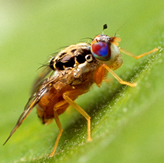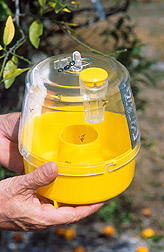This page has been archived and is being provided for reference purposes only. The page is no longer being updated, and therefore, links on the page may be invalid.
Success Controlling Medfly
By Kim KaplanJuly 21, 2005
A lure developed by the Agricultural Research Service and Suterra LLC is helping keep the Mediterranean fruit fly out of the United States and giving other countries an effective, environmentally friendly control method.
The product, BioLure 3-Component Fruit Fly Lure, is being commercialized by Suterra, which holds the exclusive license for the ARS patents. Suterra is marketing it in the United States, Spain, South Africa, Guatemala, Mexico and Peru.
Growers and government agencies in these countries are now using BioLure 3-Component Fruit Fly Lure as an effective tool to monitor for medfly presence as well as reducing medfly populations by mass trapping.
Each year in Spain, for example, mass trapping is done on thousands of acres of citrus groves using BioLure 3-Component Fruit Fly Lure. Spanish plant health agencies have found mass-trapping with the lure is as effective as insecticides at controlling medfly damage without leaving pesticide residues on fruit or harming beneficial insects.
BioLure 3-Component Fruit Fly Lure is a combination of three compounds: ammonium acetate, putrescine and trimethylamine. It captures more medflies and fewer nontarget insects, is more consistent between batches and lasts four to eight times as long, compared to protein baits. Also, BioLure 3-Component Fruit Fly Lure attracts mostly female medflies, which is important in areas where sterile male insect control programs are being used.
Chemist Robert R. Heath and entomologist Nancy D. Epsky, at the ARS Subtropical Horticultural Research Laboratory in Miami, Fla., are experts in semiochemicals—chemical signals for insect communication. Heath and Epsky worked with scientists at Suterra, who are experts at long-term controlled release of volatile chemicals, to develop the new lure.
The medfly is one of the most destructive agricultural insects in the world. The United States is eager to see medfly populations reduced in other countries because if they become established here, it could cost as much as $1.5 billion dollars a year due to export sanctions, lost markets, treatment costs and crop losses.
ARS is the U.S. Department of Agriculture's chief scientific research agency.


